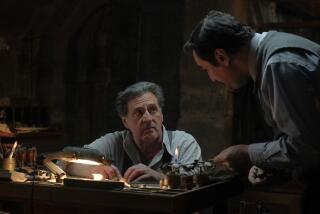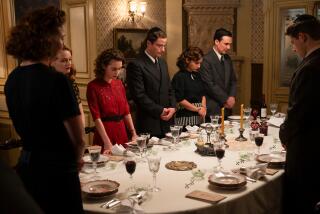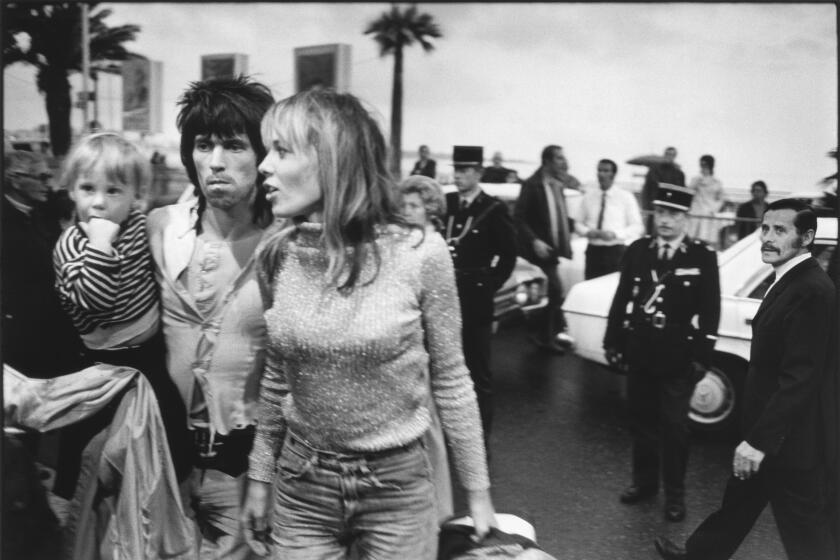Tackling the iconic ‘Ben-Hur’ presents an epic-sized challenge

Jack Huston, Morgan Freeman and Toby Kebbell star in “Ben-Hur.”
The film “Ben-Hur” was shooting in the south of Italy last year when some disturbing news reached the set: ISIS had executed Christians on a beach just across the Mediterranean, in Libya.
The movie’s principals found the parallels unsettling. As they were making a story about strife between Romans and Jews nearly 2000 years before, religious-based violence was again sweeping the globe.
“I don’t want to make it seem as if our movie speaks to every conceivable issue,” said Sean Daniel, the producer who helped originate the film, which arrives in theaters Friday from Paramount. “But it was, ‘holy cow,’ we’re making this movie about the world in turmoil and several thousand years later it was still happening. It was a powerful moment.”
A new “Ben-Hur.” The very notion seems startling, almost sacrilegious. William Wyler’s 1959 film of the same name, about the Jesus-era relationship between a Jew and a Roman, is famous for its 11 Oscars, its star-making turn from Charlton Heston, its soaring epic-ness and, of course, its climactic chariot race. The work is one of the best known in the film canon, a classic synonymous with Hollywood history.
See the most-read stories in Entertainment this hour »
Yet ready or not, here comes a who’s who of the modern film world to take another stab at it.
There’s Daniel (“The Mummy”), the Kazakh stylist director Timur Bekmambetov (“Wanted”), the prestige screenwriter John Ridley (“12 Years a Slave”), the faith-minded television producers Roma Downey and Mark Burnett (“The Bible,” “Survivor,”), even an actor with a Golden Age of Hollywood last name (Jack Huston, grandson of John and great-grandson of Walter).
The group came together to revisit the material, drawing from the same Lewis Wallace post-Civil War bestseller on which Wyler’s work and a 1925 silent film were based, — only this time with modern touches.
Like the chariot scene, shot mostly in the style of a NASCAR race, over six weeks.
Or the themes, transmuted from furious revenge to feel-good forgiveness.
With a more prominent and evangelical-friendly spiritual quotient (in the context of a $130-million summer tentpole).
Oh, and in 3-D.
Skeptical? Intrigued? Worried? A little of all three?
Its creators were, anyway.
“A lot of [film] people would look at ‘Ben-Hur’ and say ‘I’ m not going to touch that,’” said Ridley, who came on to work on the screenplay after Keith Clarke’s script landed with Daniel and production company MGM. “But as fantastic as the 1959 film was, there are things you want to excavate more clearly, relationships you want to look at more closely. When I realized that, I went from skepticism and trepidation to, ‘there’s a way forward.’”
The reboot trap?
Many modern films are susceptible to what you might call the reboot trap. Deviate from an original and people say you messed with the good. Make it too similar and people ask why you bothered in the first place.
“Ben-Hur” faces this same problem, only somehow larger. Filmmakers have to diverge from a classic without disrespecting it.
What Bekmambetov and his team did was try to carve out some middle ground. In putting their spin on a 20th century staple, they’ve created a story that’s not as iconic as you remember but not as sacrilegious as you fear.
The costumes are in period but without excessive, as Bekmambetov puts it, “towels hanging off them.”
And if the setup of estranged pals building toward a showdown can feel stodgy, the director looks to make it pay off with military scenes modeled after Delta force videos he found on YouTube and a chariot race (no green-screen, a lot of horses) shot using GoPro cameras and other documentary techniques.
The big plot beats are often the same too. During a time of great Empire conflict, the Jewish Judah Ben-Hur (Huston) is betrayed by, and sold into slavery because of, his childhood confidante, the Roman officer Messala (Toby Kebbell). Judah then sets out to avenge Messala via a deadly race.
But there are strategic changes. The inciting incident that brings Messala and Judah to loggerheads is handled differently; so too is the pair’s relationship, here that of adopted brothers. The chariot race feels different too, a taut 10-minute affair with an Olympics-like vibe.
Maybe most significant is that Jesus is a far more prominent figure in this film than in the Heston picture. Where he was previously seen in the shadows, inspirational only by proxy, here he makes several key appearances, including in a post-race scene that shades the film’s climax differently.
“Here’s a character we’ve seen so many times,” said the Brazilian-born actor Rodrigo Santoro, who plays Jesus and sought out and received the blessing of Pope Francis at the Vatican before tackling the role. “How could we humanize him?” How can we bring the figure closer and not a distant, son of God teacher? How can we enliven the portrayal with the world we live in?”
Filmmakers say their reasoning for an expanded portrayal of Jesus and more forgiveness generally was simple: In 1959, with global religious divisions neither as prominent nor as bloody, revenge could rule the day. in 2016, the world may not need more of that.
“Big Hollywood movies used to finish with revenge. In our movie, that’s the low point of the story. By winning, by killing, you’re losing everything you had,” said Bekmambetov. “And that was the trickiest and most dangerous part of the project: How can we change the Hollywood mood?”
That shift wasn’t easy. From Huston to the screenwriters, the reaction was one of skepticism.
“People would say, when we took the script out, ‘how can you go up against 11 Oscars?’” said Clarke, who was motivated to write “Ben-Hur” after he and wife-producing partner Joni Levin took a trip to Israel and saw the Israeli-Palestinian conflict.
Clarke said that before he arrived at MGM, studio executives he pitched would shake their heads. He urged them to consider the modern implications. “[T]his is a very contemporary story. It’s about fear and anger, and how we’re ruled by it today just as we were then.”
Bekmambetov went further: “We live in a Roman Empire. It’s a place where we believe that everything is about competition and power and success. You see it in the political world, in global confrontations. And either we learn how to forgive or we’re all going to kill each other.”
That the personalities on set were as different, religiously speaking, as you can imagine helped hone this message — and, perhaps, make it more universal. Downey and Burnett are staunch Catholics; Ridley is also a devout Christian, Huston and Bekmambetov, who was raised in a Communist country, are more secular; Daniel and MGM principal Gary Barber are Jewish.
“It’s kind of a unique coalition,” Daniel said. “But ‘Ben-Hur’ is a unique combination — it’s both spectacle and values.”
Marketing a hybrid
As noble as such a hybrid sounds, though, it can present plenty of marketing challenges.
Faith-based audiences turn out to see movies like “Heaven Is for Real” and “God is Not Dead.” But even Biblical and historical movies will fail if they don’t come with more explicit Christian elements; Paramount itself learned this the hard way when its “Noah” failed to resonate with a faith-based audience.
At the same time, too much religion could signal to a large secular audience — the kind required for a summer tentpole — that this film isn’t for them.
Paramount has tried to walk the line carefully. It released one trailer that barely noted the religious elements and another rife with Jesus imagery that played over a song by the Christian rock band For King & Country.
Even as the studio takes out prime-time and late-night TV ads, it has crafted a kind of parallel campaign that recruited gpastors such as Rick Warren and Joel Osteen, who both have endorsed the film, and Tim Tebow, apparently now between batting-practice sessions. (“Incredibly powerful story! Charlton Heston would be proud!” Tebow tweetedafter the studio showed him the film.)
The studio says the campaigns aren’t as disparate as you’d think. “People talk about them as different audiences, but we haven’t seen that,” said Megan Colligan, Paramount’s president of worldwide marketing and distribution. “The most religious audience and the most secular audience care about the same thing: they want it to be a compelling action movie that doesn’t look too soft.”
Jonathan Glickman, MGM Motion Picture Group president, said: “It’s really for both groups, We were trying not to lean too hard into either aspect.” (Rights to the Wyler film are actually owned by Warner Bros; MGM in this case wasn’t scavenging its own library.)
It is the faith-based audience, though, that offers the companies’ encouragement that early tracking — currently at a low $15-million opening weekend — might be off-base. Paramount and MGM executives also believe the movie could play well beyond its debut weekend, with big summer flicks such as “Jason Bourne” and “Suicide Squad” having cleared out.
They’re relying on the Olympics too. “Ben-Hur’ had to be pushed from February due to a lengthy post-production time, especially after a late-stage decision to convert to 3-D. Filmmakers are banking that a release on Olympics’ closing weekend will a give them a Rio-related boost.
A set of NBC spots in the coming days, including one that intersperses scenes from the film with moments of Olympic glory, underlines the point. Michael Phelps and Judah Ben-Hur, it turns out, aren’t all that different.
This is a very contemporary story. It’s about fear and anger, and how we’re ruled by it today just as we were then.
— Keith Clarke
A more modern approach
Moviegoers these days could be understood for feeling a little worn out by filmmaker lines justifying reboot culture. Hollywood explanations for revisiting classics may sound like a reasonable, Shakespeare-is-staged-all-the-time rationale to those uttering them. But they can come off as cynical justifications to those of us listening.
Perhaps sensing that fatigue, some voices on the film wondered if the movie should be called “Judah and Messala,” or another title that quietly suggested Wyler’s “Ben-Hur” without publicly setting up a comparison to it.
Still, viewing this movie as simply an Eisenhower-era rehash might be a bit of an oversimplification.
“Ben-Hur,” after all, offered a way of seeing history from the present long before Wyler came along: Wallace himself was seeking to find Reconstruction-era harmony by holding up a kind of ancient period-mirror to 1880’s America.
The idea of a movie that’s connected to an earlier age of Hollywood could also hold some virtue on its own, simply by reminding that a superhero-crazed industry has not forgotten its roots. “There’s something beautiful about the continuity, even by osmosis,” said Huston, noting his own family ties to the era.
Ridley, for his part, said that a more contemporary approach to race and representation than the 1959 film — one in which a white Welsh actor like Hugh Griffith didn’t don paint to play an Arab sheik — “was reason right there to come back to it.”
But maybe the most potent argument made on the film’s behalf comes with the idea that the telling of this film’s story is inextricable with its retelling. The new ”Ben-Hur” is less the product of a 1950s nostalgia-raid than as part of a long and eternal chain.
“The Wyler movie came out in 1959, some 30 years after the silent movie,” Kebbell said.
“You can imagine the complaints then. ‘The talkies. All these monologues. It’s ruining the action. Why are you messing with my childhood?’ They messed with someone’s childhood. We’re messing with theirs.
“And one day,” he continued, “someone will mess with ours.”
Twitter: @ZeitchikLAT
More to Read
Only good movies
Get the Indie Focus newsletter, Mark Olsen's weekly guide to the world of cinema.
You may occasionally receive promotional content from the Los Angeles Times.







